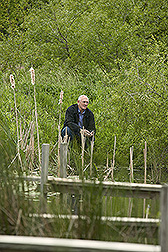Forum—Upgrading America’s Underground Drainage Network
|
|
There is a revolution or revamping going on that could dramatically change the American farm underground landscape and downstream water quality in the next 5 years.
The revolution centers around a new controlled-drainage system that allows growers to vary the water table and underground drainage outflows in various parts of a field.
Through the years, underground drain pipes have been installed to drain water so farmers can till and plant. As indispensable as these drains are to agricultural productivity, they have the potential to carry off nutrients. And Midwest drains have been identified as a possible source of fertilizer nitrates and phosphorus entering the Gulf of Mexico.
The process to tackle this problem began recently when USDA’s Natural Resources Conservation Service (NRCS) relayed to USDA’s Agricultural Research Service (ARS) that more information was needed to help farmers decide how to improve farm drainage and address water-quality issues.
The two agencies have teamed up to lead an effort to educate and assist farmers nationwide to upgrade these systems. Together we formed the Agricultural Drainage Management Systems (ADMS) Task Force, joining with a growing number of researchers and extension personnel from universities. Our task force is continually expanding, now including scientists from many local, state, and federal agencies, including the U.S. Environmental Protection Agency, U.S. Geological Survey, and others.
The ADMS Task Force began 2 years ago when the USDA Partnership Management Team agreed that this would be its first technical working group. The USDA Partnership Management Team consists of ARS, NRCS, and the Cooperative State Research, Education, and Extension Service.
Our mission is to carry forth the motto: “Save Our Precious Resources from Going Down the Drain.” Loss of nitrates and phosphorus not only has potential to harm the environment but also wastes farmers’ money spent on fertilizer.
As the story "Underground Drainage: A Secret of America's Bounty" in this issue of the magazine shows, ARS gears its research toward providing NRCS with the needed answers. ARS’s efforts and university research provide the scientific basis for NRCS standards and recommendations. In 2001, NRCS released a new standard for drainage to reflect the latest information available, including management and controlled-drainage techniques.
Controlled drainage uses valves to open and close drainage pipes and structures to control the depth of the water table. When properly managed, controlled drainage saves water, allowing the water table to decline as the season progresses. Water and nutrients remain usable by the crop, frequently resulting in increased yields, and the flow of nitrates off a field can be reduced by as much as 45 percent.
NRCS and ARS began an intensified effort to encourage the use of controlled and managed drainage, along with other related conservation technologies, in the Midwest. Financial incentives in five Midwestern states and North Carolina are paying part of the costs of installing the control structures and valves for drainage pipes, with Illinois leading the way. Midwestern farmers have increased the amount of acreage making use of these practices from under 500 acres in 2004 to about 4,000 acres. As we spread drainage improvements nationally, we are looking west, starting with California. The ARS San Joaquin Valley Agricultural Sciences Center is researching controlled-drainage techniques that could reduce the problem of salinity buildup on irrigated lands.
NRCS sees this drainage package as the next logical step to follow the agency’s buffer initiative, which sought to have farmers install 2 million miles of grass or other vegetative buffers to filter sediment and chemicals out of runoff water.
What will be the goal for controlled drainage?
Future efforts will focus on raising awareness of the NRCS Drainage Water Management conservation practice standard and the importance of updating the nation’s drainage of farmland. Workshops for farmers will provide tools and information showing that water saved by improved drainage is a mitigation source during droughts. By having this reserve supply of water and the retained nutrients previously lost, yields and net farming revenues can be sustained and possibly increased.
The timing is right to upgrade America’s underground drainage network. Pipes installed in the 1960s are nearing the end of their useful life, and we now have the knowledge and technology to replace them. We expect farmers to turn to the new technology when renovating.
Improved drainage management has benefits to society at large, with direct and indirect benefits from having cleaner water and sustained, viable, and productive agricultural lands.
Dale Bucks
ARS Senior National Program Leader
Water Quality and Water Management
Advisor to ADMS Task Force
Beltsville, Maryland
Tom Spofford
NRCS National Water Management Engineer
Advisor to ADMS Task Force
Washington, D.C.
"Forum" was published in the September 2005 issue of Agricultural Research magazine.







